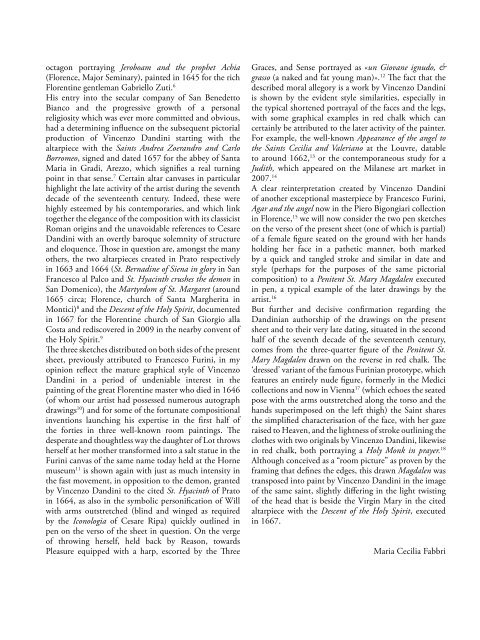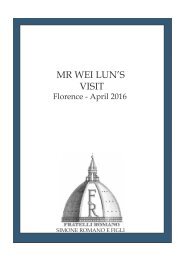A selection of master drawings 2016
- No tags were found...
Create successful ePaper yourself
Turn your PDF publications into a flip-book with our unique Google optimized e-Paper software.
octagon portraying Jeroboam and the prophet Achia<br />
(Florence, Major Seminary), painted in 1645 for the rich<br />
Florentine gentleman Gabriello Zuti. 6<br />
His entry into the secular company <strong>of</strong> San Benedetto<br />
Bianco and the progressive growth <strong>of</strong> a personal<br />
religiosity which was ever more committed and obvious,<br />
had a determining influence on the subsequent pictorial<br />
production <strong>of</strong> Vincenzo Dandini starting with the<br />
altarpiece with the Saints Andrea Zoerandro and Carlo<br />
Borromeo, signed and dated 1657 for the abbey <strong>of</strong> Santa<br />
Maria in Gradi, Arezzo, which signifies a real turning<br />
point in that sense. 7 Certain altar canvases in particular<br />
highlight the late activity <strong>of</strong> the artist during the seventh<br />
decade <strong>of</strong> the seventeenth century. Indeed, these were<br />
highly esteemed by his contemporaries, and which link<br />
together the elegance <strong>of</strong> the composition with its classicist<br />
Roman origins and the unavoidable references to Cesare<br />
Dandini with an overtly baroque solemnity <strong>of</strong> structure<br />
and eloquence. Those in question are, amongst the many<br />
others, the two altarpieces created in Prato respectively<br />
in 1663 and 1664 (St. Bernadine <strong>of</strong> Siena in glory in San<br />
Francesco al Palco and St. Hyacinth crushes the demon in<br />
San Domenico), the Martyrdom <strong>of</strong> St. Margaret (around<br />
1665 circa; Florence, church <strong>of</strong> Santa Margherita in<br />
Montici) 8 and the Descent <strong>of</strong> the Holy Spirit, documented<br />
in 1667 for the Florentine church <strong>of</strong> San Giorgio alla<br />
Costa and rediscovered in 2009 in the nearby convent <strong>of</strong><br />
the Holy Spirit. 9<br />
The three sketches distributed on both sides <strong>of</strong> the present<br />
sheet, previously attributed to Francesco Furini, in my<br />
opinion reflect the mature graphical style <strong>of</strong> Vincenzo<br />
Dandini in a period <strong>of</strong> undeniable interest in the<br />
painting <strong>of</strong> the great Florentine <strong>master</strong> who died in 1646<br />
(<strong>of</strong> whom our artist had possessed numerous autograph<br />
<strong>drawings</strong> 10 ) and for some <strong>of</strong> the fortunate compositional<br />
inventions launching his expertise in the first half <strong>of</strong><br />
the forties in three well-known room paintings. The<br />
desperate and thoughtless way the daughter <strong>of</strong> Lot throws<br />
herself at her mother transformed into a salt statue in the<br />
Furini canvas <strong>of</strong> the same name today held at the Horne<br />
museum 11 is shown again with just as much intensity in<br />
the fast movement, in opposition to the demon, granted<br />
by Vincenzo Dandini to the cited St. Hyacinth <strong>of</strong> Prato<br />
in 1664, as also in the symbolic personification <strong>of</strong> Will<br />
with arms outstretched (blind and winged as required<br />
by the Iconologia <strong>of</strong> Cesare Ripa) quickly outlined in<br />
pen on the verso <strong>of</strong> the sheet in question. On the verge<br />
<strong>of</strong> throwing herself, held back by Reason, towards<br />
Pleasure equipped with a harp, escorted by the Three<br />
Graces, and Sense portrayed as «un Giovane ignudo, &<br />
grasso (a naked and fat young man)». 12 The fact that the<br />
described moral allegory is a work by Vincenzo Dandini<br />
is shown by the evident style similarities, especially in<br />
the typical shortened portrayal <strong>of</strong> the faces and the legs,<br />
with some graphical examples in red chalk which can<br />
certainly be attributed to the later activity <strong>of</strong> the painter.<br />
For example, the well-known Appearance <strong>of</strong> the angel to<br />
the Saints Cecilia and Valeriano at the Louvre, datable<br />
to around 1662, 13 or the contemporaneous study for a<br />
Judith, which appeared on the Milanese art market in<br />
2007. 14<br />
A clear reinterpretation created by Vincenzo Dandini<br />
<strong>of</strong> another exceptional <strong>master</strong>piece by Francesco Furini,<br />
Agar and the angel now in the Piero Bigongiari collection<br />
in Florence, 15 we will now consider the two pen sketches<br />
on the verso <strong>of</strong> the present sheet (one <strong>of</strong> which is partial)<br />
<strong>of</strong> a female figure seated on the ground with her hands<br />
holding her face in a pathetic manner, both marked<br />
by a quick and tangled stroke and similar in date and<br />
style (perhaps for the purposes <strong>of</strong> the same pictorial<br />
composition) to a Penitent St. Mary Magdalen executed<br />
in pen, a typical example <strong>of</strong> the later <strong>drawings</strong> by the<br />
artist. 16<br />
But further and decisive confirmation regarding the<br />
Dandinian authorship <strong>of</strong> the <strong>drawings</strong> on the present<br />
sheet and to their very late dating, situated in the second<br />
half <strong>of</strong> the seventh decade <strong>of</strong> the seventeenth century,<br />
comes from the three-quarter figure <strong>of</strong> the Penitent St.<br />
Mary Magdalen drawn on the reverse in red chalk. The<br />
‘dressed’ variant <strong>of</strong> the famous Furinian prototype, which<br />
features an entirely nude figure, formerly in the Medici<br />
collections and now in Vienna 17 (which echoes the seated<br />
pose with the arms outstretched along the torso and the<br />
hands superimposed on the left thigh) the Saint shares<br />
the simplified characterisation <strong>of</strong> the face, with her gaze<br />
raised to Heaven, and the lightness <strong>of</strong> stroke outlining the<br />
clothes with two originals by Vincenzo Dandini, likewise<br />
in red chalk, both portraying a Holy Monk in prayer. 18<br />
Although conceived as a “room picture” as proven by the<br />
framing that defines the edges, this drawn Magdalen was<br />
transposed into paint by Vincenzo Dandini in the image<br />
<strong>of</strong> the same saint, slightly differing in the light twisting<br />
<strong>of</strong> the head that is beside the Virgin Mary in the cited<br />
altarpiece with the Descent <strong>of</strong> the Holy Spirit, executed<br />
in 1667.<br />
Maria Cecilia Fabbri





